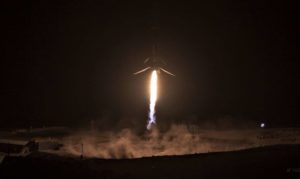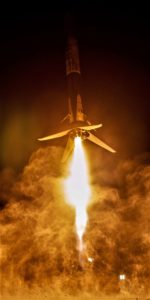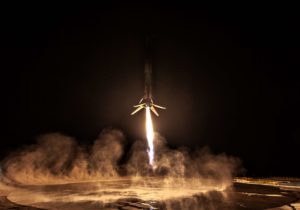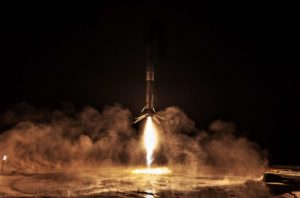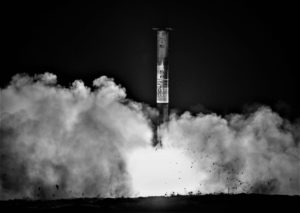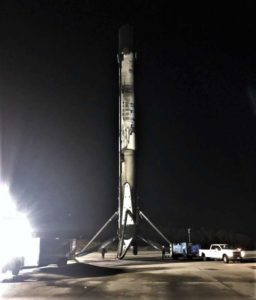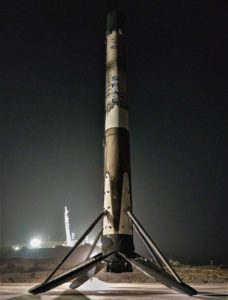

News
SpaceX’s Falcon 9 returns to Earth in first on-site media photos of rocket recovery
Thanks to the introduction of a brand new rocket landing pad (LZ-4) less than half a kilometer (~0.3 miles) from SpaceX’s SLC-4 Vandenberg launch complex, members of the media attending the launch were given the first opportunity ever to capture a Falcon booster recovery with remote cameras.
Battling the possibility that SpaceX might forbid landing photos entirely or that Vandenberg’s infamous fog banks would forbid them in a different sense, cautious optimism was ultimately warranted, and picture-perfect weather lead to both an extraordinary light show over much of California and the successful capture of the first unofficial remote images of a Falcon 9 landing.
SpaceX landed a booster at Vandenberg for the first time, in case you hadn’t heard! Here are a few frames from one of my remote cameras aimed at the landing zone (LZ-4).#spaceX #SAOCOM1A @Teslarati pic.twitter.com/w2FMM5DJRQ
— Pauline Acalin (@w00ki33) October 8, 2018
Following successful separation from Falcon 9’s upper stage and the SAOCOM 1A satellite payload, booster B1048 immediately began a rapid 180-degree flip maneuver, igniting either one or three of its Merlin 1D engines to begin its journey back to the launch site. After cancelling out a velocity of roughly 2 kilometers per second in the wrong direction, B1048 dropped almost straight down from a peak altitude of ~50 km to the landing zone, punctuated by a reentry burn used to protect the rocket from the brunt of atmospheric reentry heating.
A bit less than eight minutes after launch, the first stage broke through the sound barrier, began a single-engine landing burn, deployed its landing legs, and came to a gentle rest at Landing Zone-4, B1048’s second successful launch and landing. Thanks to the low-energy orbit, relatively small satellite, and Falcon 9 Block 5’s healthy performance margins, B1048 likely experienced the most forgiving recovery conditions since SpaceX began landing and reusing boosters, making the rocket a prime candidate to be the first SpaceX Falcon 9 booster to fly three times.
- Falcon 9 B1048’s SLC-4E launch and LZ-4 launch in one camera frame. (Pauline Acalin)
- Teslarati’s own Pauline Acalin managed to capture a number of extraordinary photos of launch and landing with her remote cameras. (Pauline Acalin)
- Falcon 9 B1048.2 landed at LZ-4 after its second successful launch. (SpaceX)
- (SpaceX)
- It’s second landing marked the debut of SpaceX’s LZ-4 landing zone. B1048 may be a prime candidate for SpaceX’s first triple booster reuse. (SpaceX)
- (SpaceX)
- (SpaceX)
- Falcon 9 B1048 landed at LZ-4 after its second launch and is now being refurbished on the opposite coast. (SpaceX)
Even more so, the fact that B1048 landed barely ~2000 feet from SpaceX’s SLC-4 hangar – where it will be inspected and refurbished – will be a boon for rapid and affordable reusability, thanks to the fact that SpaceX does not have to operate any complex ships, shut down public roads, or transport the recovered rocket more than a few thousand feet. SpaceX confirmed as much during its SAOCOM 1A webcast.
Not yet officially on the schedule, SpaceX’s next Vandenberg launch is expected to be Spaceflight Industries’ SSO-A rideshare mission, carrying around 70 individual satellites of varying masses. Chronically delayed by the complexity of wrangling 70 different spacecraft into a single fairing and – more recently – minor issues with rocket availability, several of SSO-A’s passengers have provided a tentative launch date of November 19th, 2018. If SpaceX is planning to reuse B1048 a third time with SSO-A, that will demand a record-breaking turnaround for the booster, as few as 42 days between landing #2 and launch #3.
For prompt updates, on-the-ground perspectives, and unique glimpses of SpaceX’s rocket recovery fleet check out our brand new LaunchPad and LandingZone newsletters!
News
Tesla begins Robotaxi certification push in Arizona: report
Tesla seems serious about expanding its Robotaxi service to several states in the coming months.

Tesla has initiated discussions with Arizona transportation regulators to certify its driverless Robotaxi service in the state, as per a recent report from Bloomberg News. The move follows Tesla’s launch of its Robotaxi pilot program in Austin, Texas, as well as CEO Elon Musk’s recent comments about the service’s expansion in the Bay Area.
The Arizona Department of Transportation confirmed to Bloomberg that Tesla has reached out to begin the certification process for autonomous ride-sharing operations in the state. While details remain limited, the outreach suggests that Tesla is serious about expanding its driverless Robotaxi service to several territories in the coming months.
The Arizona development comes as Tesla prepares to expand its service area in Austin this weekend, as per CEO Elon Musk in a post on X. Musk also stated that Tesla is targeting the San Francisco Bay Area as its next major market, with a potential launch “in a month or two,” pending regulatory approvals.
Tesla first launched its autonomous ride-hailing program on June 22 in Austin with a small fleet of Model Y vehicles, accompanied by a Tesla employee in the passenger seat to monitor safety. While still classified as a test, Musk has said the program will expand to about 1,000 vehicles in the coming months. Tesla will later upgrade its Robotaxi fleet with the Cyercab, a two-seater that is designed without a steering wheel.
Sightings of Cybercab castings around the Giga Texas complex suggests that Tesla may be ramping the initial trial production of the self-driving two-seater. Tesla, for its part, has noted in the past that volume production of the Cybercab is expected to start sometime next year.
In California, Tesla has already applied for a transportation charter-party carrier permit from the state’s Public Utilities Commission. The company is reportedly taking a phased approach to operating in California, with the Robotaxi service starting with pre-arranged rides for employees in vehicles with safety drivers.
News
Tesla sets November 6 date for 2025 Annual Shareholder Meeting
The automaker announced the date on Thursday in a Form 8-K.

Tesla has scheduled its 2025 annual shareholder meeting for November 6, addressing investor concerns that the company was nearing a legal deadline to hold the event.
The automaker announced the date on Thursday in a Form 8-K submitted to the United States Securities and Exchange Commission (SEC). The company also listed a new proposal submission deadline of July 31 for items to be included in the proxy statement.
Tesla’s announcement followed calls from a group of 27 shareholders, including the leaders of large public pension funds, which urged Tesla’s board to formally set the meeting date, as noted in a report from The Wall Street Journal.
The group noted that under Texas law, where Tesla is now incorporated, companies must hold annual meetings within 13 months of the last one if requested by shareholders. Tesla’s previous annual shareholder meeting was held on June 13, 2024, which placed the July 13 deadline in focus.
Tesla originally stated in its 2024 annual report that it would file its proxy statement by the end of April. However, an amended filing on April 30 indicated that the Board of Directors had not yet finalized a meeting date, at least at the time.
The April filing also confirmed that Tesla’s board had formed a special committee to evaluate certain matters related to CEO Elon Musk’s compensation plan. Musk’s CEO performance award remains at the center of a lengthy legal dispute in Delaware, Tesla’s former state of incorporation.
Due to the aftermath of Musk’s legal dispute about his compensation plan in Delaware, he has not been paid for his work at Tesla for several years. Musk, for his part, has noted that he is more concerned about his voting stake in Tesla than his actual salary.
At last year’s annual meeting, TSLA shareholders voted to reapprove Elon Musk’s compensation plan and ratified Tesla’s decision to relocate its legal domicile from Delaware to Texas.
Elon Musk
Grok coming to Tesla vehicles next week “at the latest:” Elon Musk
Grok’s rollout to Tesla vehicles is expected to begin next week at the latest.

Elon Musk announced on Thursday that Grok, the large language model developed by his startup xAI, will soon be available in Tesla vehicles. Grok’s rollout to Tesla vehicles is expected to begin next week at the latest, further deepening the ties between the two Elon Musk-led companies.
Tesla–xAI synergy
Musk confirmed the news on X shortly after livestreaming the release of Grok 4, xAI’s latest large language model. “Grok is coming to Tesla vehicles very soon. Next week at the latest,” Musk wrote in a post on social media platform X.
During the livestream, Musk and several members of the xAI team highlighted several upgrades to Grok 4’s voice capabilities and performance metrics, positioning the LLM as competitive with top-tier models from OpenAI and Google.
The in-vehicle integration of Grok marks a new chapter in Tesla’s AI development. While Tesla has long relied on in-house systems for autonomous driving and energy optimization, Grok’s integration would introduce conversational AI directly into its vehicles’ user experience. This integration could potentially improve customer interaction inside Tesla vehicles.
xAI and Tesla’s collaborative footprint
Grok’s upcoming rollout to Tesla vehicles adds to a growing business relationship between Tesla and xAI. Earlier this year, Tesla disclosed that it generated $198.3 million in revenue from commercial, consulting, and support agreements with xAI, as noted in a report from Bloomberg News. A large portion of that amount, however, came from the sale of Megapack energy storage systems to the artificial intelligence startup.
In July 2023, Musk polled X users about whether Tesla should invest $5 billion in xAI. While no formal investment has been made so far, 68% of poll participants voted yes, and Musk has since stated that the idea would be discussed with Tesla’s board.
-

 Elon Musk1 week ago
Elon Musk1 week agoTesla investors will be shocked by Jim Cramer’s latest assessment
-

 Elon Musk19 hours ago
Elon Musk19 hours agoxAI launches Grok 4 with new $300/month SuperGrok Heavy subscription
-

 Elon Musk3 days ago
Elon Musk3 days agoElon Musk confirms Grok 4 launch on July 9 with livestream event
-

 News7 days ago
News7 days agoTesla Model 3 ranks as the safest new car in Europe for 2025, per Euro NCAP tests
-

 Elon Musk2 weeks ago
Elon Musk2 weeks agoA Tesla just delivered itself to a customer autonomously, Elon Musk confirms
-

 Elon Musk1 week ago
Elon Musk1 week agoxAI’s Memphis data center receives air permit despite community criticism
-

 Elon Musk2 weeks ago
Elon Musk2 weeks agoTesla’s Omead Afshar, known as Elon Musk’s right-hand man, leaves company: reports
-

 News2 weeks ago
News2 weeks agoXiaomi CEO congratulates Tesla on first FSD delivery: “We have to continue learning!”


